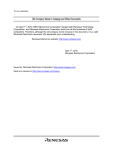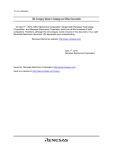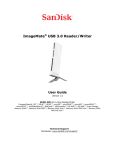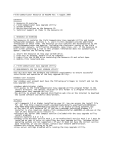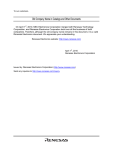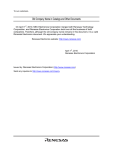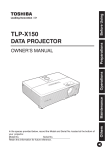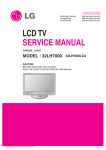Download Data processor and data processing system
Transcript
US005961641A Ulllted States Patent [19] [11] Patent Number: 5,961,641 Hasegawa et al. [45] Oct. 5, 1999 [54] Date of Patent: DATA PROCESSOR AND DATA PROCESSING 5,444,861 SYSTEM 5,675,800 5,680,620 [75] Inventors: Hironobu Hasegawa, Kodaira; Hiroyuki Sasaki, Fucyu; Masahiko Uraguchia Higashimurayama> an of 8/1995 Adamec et a1. .. .... .. 395/700 10/1997 Fisher, Jr. et a1. . .... .. 395/700 10/1997 Ross ...................................... .. 395/704 OTHER PUBLICATIONS DSP 96002 User’s Manual, Section 10, On—Chip Emulator, Japan pp. 10_1_10_22. [73] Assignee: Hitachi, Ltd., Tokyo, Japan Primary ExaminerAiassan KiZou Assistant Examiner—Omar A. Omar [21] Appl. No.: 08/864,970 _ [22] Filed: Minnich & McKee May 29, 1997 _ [30] Attorney, Agent, or Firm—Fay, Sharpe, Beall, Fagan, _ _ _ _ [57] Foreign Application Priority Data May 31, 1996 [JP] ABSTRACT Japan .................................. .. 8-138111 A data processor has a ROM that holds a boot program for Causing the CPU to transfer a debug program from a Serial interface circuit to a debug-use RAM area. When supplied [51] Int. Cl.6 ................................................. .. G06F 15/177 [52] US, Cl, 713/1; 709/208 externally With an SDI boot command, the serial interface [58] Field of Search ................................... .. 395/700, 704; 364/200; 713/1; 709/208; 710/15; 714/34 Circuit Outputs an SDI interrupt request Signal (SDIibOOt) to an interrupt controller. The signal causes the CPU to execute the boot program. Debug operations are varied as per the ________________ [56] _ _ _ __ References Cited contents of the doWnloaded debug program, and data exchanges upon debugging are carried out serially. U.S. PATENT DOCUMENTS 4,451,882 5/1984 Dshkhunian et a1. ................ .. 364/200 21 Claims, 15 Drawing Sheets _____________ " 1 MI CROCOMPUTER 4 16A, 16D 3 ‘5 14 BREAK /TRST ——> CONTROLLER ll TCK —’ DEBUGGING SERIAL TOOL CONTROLLER sm INTERNAL MEMORY TMS _* l2 TDI ——> SDl_boot TD() 4- SD|_i nt INTERRUPT SDl_brk CONTROLLER 13 TO CPU EXTERNAL MEMORY BUS CONTROLLER l7 SYSTEM F \A 2 5 TARGET SYSTEM CONTROLLER 19/ I ASEMDO I ,1 /RST U.S. Patent 0a. 5, 1999 Sheet 3 0f 15 5,961,641 F/G. 3 K m T82 T81 T80 —* —* * : RESERVED BIT T82 T81 T50 COMMAND I 0 O BOOT COMMAND I 0 I SDI INTERRUPT COMMAND I I 0 SDI BREAK COMMAND F/G. 4 ASEMDO COMMENT O ASE MODE (EVALUATION CHI P MODE) I MAIN UNIT CHIP MODE (PRODUCT CH I P MODE) U.S. Patent 0a. 5, 1999 o. 5,961,641 6.Em a: 2%o _ _5- 56 Sheet 4 0f 15 _E E0 ED 25Q 3.5_ 2%_ 5-2% _ c .Eoma; ‘7 o #95_ m hw N5 _ o U.S. Patent 0a. 5, 1999 Sheet 5 0f 15 FIG. 5 H' 0000000 USER MEMORY AREA (User_MEM) H’ 1000000 EXTERNAL MEMORY SPACE HI 4000000 W///////////// / RESERVED SPAy HI 9000000 W % @EééQE?ééXéK/ H' M00000 ’?zxxzxxy” RESERVED SPACE HI B000000 ERVED CE PERIPHERAL MODULE SPACE HI E000000 y //////////// RESERVED SPACE H' F000000 / RESERVED ///////// CE // PRODUCT MODE 5,961,641 U.S. Patent 0a. 5, 1999 Sheet 6 0f 15 5,961,641 P76. 7 H 0000000 M] I 0 USER MEMORY AREA (User_MEM) H' 1000000 EXTERNAL MEMORY SPACE H' 4000000 / RESERVED SPACE HI 9000000 RESERVED SPACE H, M00000 V//////////// ////////// 7% RESERVED SPACE / HI 3000000 RESERVED SPACE PERIPHERAL MODULE SPACE H’ [5000090 7 ////////////7 ///////// RESERVED SPACE / // % // H ' F 0 0 0 0 0 0 7 //////§§§5§§7/ RESERVED SPACE //////////// EVALUATION MODE (USER MODE) U.S. Patent 0a. 5, 1999 Sheet 7 0f 15 5,961,641 F/G. 8 H 0000000 V1 } 0 USER MEMORY AREA (User_MEM) HI 1000000 EXTERNAL MEMORY SPACE H' 4000000 ZM H’ 9000000‘ H- M00000 % RESERVED SPACE ///////////// ATOR SPACE E TERNAL) H' 5000000 7 ////////////y RESERVED SPACE H’COOOOOO % ///////Z///// % / PERI PHERAL MODULE SPACE H’ EOOOOOU / 7 ////////////V RESERVED SPACE HI % ///////////// EMULATOR /// / CE (INTERNA EVALUATION MODE (BREAK MODE) U.S. Patent 5,961,641 FIG. 9 H' FFFF8OO xv] 1 1 RRBRAG %///%//% HI FFFFCOO H'FFFFFCO % f //B BO (B H'FFFFFFO w] 1 2 ROGRAM AREA Program) R0 SAVE AREA W1 HA H‘ FFFFFF4 HARDWARE BREAK VECTOR AREA ~1 '15 H'FFFFFF8 SOFTWARE BREAK VECTOR AREA ~1 1 '0 H'FFFFFFC SDI BOOT VECTOR AREA ~1 12A INTERNAL EMULATOR SPACE IN BREAK MODE U.S. Patent 5,961,641 Sheet 9 0f 15 0a. 5, 1999 FIG. 70 BOOT FLOW BRING /RST AND /TRST LOW I S2 ENTER RESET HOLD STATE (BREAK MODE) I S3 DRIVE /RST HIGH AND THEN /TRST HIGH TO KEEP RESET HOLD STATE I S4 INPUT BOOT COMMAND VIA TDI I S5 GET BOOT COMMAND DECODED INSIDE SDI TO OUTPUT SDI_boo'I: SIGNAL TO INTERRUPT CONTROLLER I S6 LEAVE RESET HOLD STATE USING SDI_boot SIGNAL BEFORE EXECUTING BOOT PROGRAM I 87 DOWNLOAD DATA FROM TDI TO ASERAM I S8 BRANCH TO STARTING ADDRESS OF ASERAM AFTER DOWNLOADING TO ASERAM I EXECUTE PROGRAM IN ASERAM S9 U.S. Patent 0a. 5, 1999 Sheet 10 0f 15 5,961,641 F/G. 77 t1 t2 t3 t4 t5 BREAK MODE EXECUTE BOOT PROGRAM _\ . / RST /TRST \ PROGRAM IN AsERAM _J T / BOOT COMMAND SERIAL EXECUTE DEBUGGING _ TRANSFERRED DATA DATA ________ -_ INPUT (TDI) SD|_boot SIGNAL A RESET HOLD (HAHN) CPU OPERATION STATUS -_/ \ I L (A) (B) (A) EXECUTION OF THE BOOT PROGRAM 1. DATA AND PROGRAMS ARE DOWNLOADED TO THE AsERAM BY EXECUTION OF THE BOOT PROGRAM (IN BREAK MODE) 2. AFTER DOWNLOADING, PROCESSING BRANCHES TO THE ASERAM (B) THE DEBUGGING PROGRAM IS EXECUTED IN THE AsERAM U.S. Patent 0a. 5, 1999 Sheet 11 0f 15 5,961,641 FIG. 72 SDI BREAK FLOW SI 0 BRING /TRST LOW (TO INITIALIZE SDI) /( EITHER IN USER MODE OR IN BREAK MODE (SDI BREAK IS NOT ACCEPTED IN PRODUCT CH I P MODE) I DRIVE /TRST HIGH SI I F I INPUT SDI BREAK COMMAND VIA TDI SI 2 F I SI 3 GET BREAK COMMAND DECODED INSI DE SDI TO OUTPUT SDI_brk SIGNAL TO INTERRUPT CONTROLLER I SI 4 ACCEPT BREAK BASED ON SDI_brk SIGNAL 5 BEFORE BRANCHING TO ASERAM I EXECUTE PROGRAM IN ASERAM (FOR EMULATION) SI 5 5 U.S. Patent 0a. 5, 1999 Sheet 12 0f 15 5,961,641 FIG. 73 USER MODE (BREAK MODE) _ BREAK MODE /RST /TRST —\ I BREAK COMMAND SERIAL TRANSFERRED DATA DATA INPUT (TDI ) :I'D ___________ __ SDI_brk SIGNAL RESET HOLD ----------- -- \ _. (INTERNAL) SIGNAL CPU OPERATION STATUS (A) (A) NORMAL OPERATION (B) GRAM EXECUTIO T. 2. 3. (B) TE THE ASERAM ARDWARE BREAK VECTOR IS READ ESSING BRANCHES TO THE ASERAM DEBUGGING PROGRAM IS EXECUTED IN THE ASERAM U.S. Patent 0a. 5, 1999 Sheet 13 0f 15 5,961,641 F/G. 74 SDI INTERRUPT FLOW S20 BRING /TRST LOW (TO INITIALIZE SDI) ; EITHER IN MAIN UNIT CH I P MODE OR IN USER MODE (SDI INTERRUPT IS NOT ACCEPTED IN BREAK MODE) I S21 DRIVE /TRST HIGH INPUT SDI I INTERRUPT COMMAND VIA F TDI 5822 S23 GET SDI INTERRUPT COMMAND DECODED 5 INSI DE SDI TO OUTPUT SDI_i nt SIGNAL TO INTERRUPT CONTROLLER I ACCEPT INTERRUPT BASED ON SDI_i nt S24 /( SIGNAL BEFORE BRANCHING TO SDI INTERRUPT ROUTINE I EXECUTE USER PROGRAM (SDI INTERRUPT ROUTINE) 7 S25 U.S. Patent 0a. 5, 1999 Sheet 14 0f 15 5,961,641 FIG. 75 t1 A t2 123 (MAIN UNIT CH I P MODE) USER MODE V /RST /TRST SERIAL -\ I DATA _____________ _ INPUT (TDI) SDI_Int SIGNAL RESET HOLD A ----------------------------------------------------------------- - (INTER SIGNA CPU OPERATION STATUS (A) (A) NORMAL OPERATION STATE (B) SDI INTERRUPTION l (B) I. AN SDI INTERRUPT VECTOR IS READ 2. THE SDI INTERRUPT VECTOR ROUTINE IS EXECUTED U.S. Patent 0a. 5, 1999 Sheet 15 0f 15 GES wza mo .62. 5,961,641 5,961,641 1 2 DATA PROCESSOR AND DATA PROCESSING SYSTEM product system) Will be operating, and to provide a data processing system that utiliZes such a data processor. These and other objects, features and advantages of the BACKGROUND OF THE INVENTION invention Will become more apparent upon a reading of the folloWing description and appended draWings. The present invention relates to data processors including microcomputers, digital signal processors, microcontrollers and microprocessors especially With debug support features In carrying out the invention and according to one aspect thereof, there is provided as outlined in FIG. 1 a data processor 1 formed on a semiconductor chip and comprising a central processing unit 10, storage means 11 accessible by such as emulation. More particularly, the invention relates to a data processor for debugging a microcomputer-based system in a real-use operation environment such as out doors. the central processing unit 10, an interrupt controller 12 for controlling interrupts to the central processing unit 10, serial interface means 15 for outputting and inputting data serially The microcomputer-based system (also called the target system) may be debugged by means of a microcomputer for evaluation use With debug support features. In interfacing the evaluation-use microcomputer to a debugging host system, a large number of signal lines may be used to 15 to and from the outside of the data processor 1, and an internal bus 16 for connecting these component means and units The storage means 11 includes a reWritable ?rst storage area 111 and a second storage area 112 holding a boot transmit in parallel data, addresses and control signals program for causing the central processing unit 10 to trans equivalent to those of the interface betWeen the microcom fer data from the serial interface means 15 to the ?rst storage area 111. The serial interface means 15 receives and decodes puter in question and the target system. HoWever, Where the a ?rst command (SDI boot command) from the outside, and outputs a ?rst interrupt request signal (SDIiboot) to the target system is appreciably small in volume as in the case of a portable communication terminal, it is often impossible practically to equip the circuit board of the system With pins or connectors for connecting numerous signal lines. One proposed solution to such a bottleneck is the use of a serial interface With the debugging host system. Technical aspects of the solution are discussed illustratively in “DSP 25 request signal. When a system to Which the data processor is applied (i.e., 96002 User’s Manual” (SECTION 10, ON-CHIP EMULA target system) is subjected to softWare or system debugging, TOR; p10—1~p10—22). a user program to be debugged is executed by the data processor. The data acquired from execution of the program is referenced externally When the user program is traced for The technique described in the publication above involves incorporating in a digital signal processor a command decoder and a break point control circuit for debugging debugging through its execution. Where any data arising purposes as Well as a serial interface for debug use Which alloWs data to be input and output serially in synchronism With a clock signal. Debug commands are fed externally to the processor through the serial interface. The command decoder decodes the commands thus supplied. The decoded interrupt controller 12 in accordance With the decoded ?rst command. The interrupt controller 12 supplies the central processing unit 10 With ?rst interrupt control data for executing the boot program in response to the ?rst interrupt 35 result is referenced in controlling Write and read operations to and from internal registers as Well as in controlling break from user program execution needs to be referenced from the outside or Where desired operating conditions are to be set for the user program, it is necessary for the data processor to execute a debug control program different from the user program. The boot program mentioned above is a program that causes the central processing unit to doWnload such a debug control program to an area different from a user points. program storage area. An appropriate debug control program may be prepared beforehand as needed depending on the constitution of the system to be debugged. In operation, the host system issues the ?rst command mentioned above to the SUMMARY OF THE INVENTION With the conventional technique outlined above, the debug command functions are predetermined ?xedly and are thus limitative of the degree of ?exibility With Which to set serial interface means. This causes the data processor to start the boot program, doWnloading the debug control program simulated internal states for a data processor or to reference from the serial interface means to the ?rst storage area. That internal states of the data processor for debugging purposes. Given the fact that data processors such as digital signal processors are adapted extensively to various data process is, When data coming out of the process of user program execution is to be referenced externally or When desired operating conditions are to be set for the user program, all ing systems, the debug support features thus restricted are operations involved are performed under control of the doWnloaded debug control program. Because all debug operations are carried out as per the suitably prepared debug not quite convenient to use. In other Words, debug opera tions lack variability. Adopting the above-mentioned serial interface reduces control program, the variability of debug operations is the number of connectors for connection With the debugging host system. HoWever, to minimiZe the number of signals guaranteed. Debug operations by the data processor are in no Way limited because of the types of commands that may be accepted by the serial interface means. requires reevaluating the control techniques of handshaking for asynchronous serial data input and output betWeen the data processor in question and its external environment. The serial interface means for interfacing With the host system reduces the number of interface terminals for debug ging purposes. Under such constraints, both the variability It is therefore an object of the present invention to provide a data processor capable of minimiZing the number of signal terminals for debugging. It is another object of the invention to provide a data processor alloWing debug operations to be varied easily. It is a further object of the invention to provide a data processor that permits debugging in an environment close to the real-use condition in Which a target machine (i.e., 65 of debug operations and the ease of use are still ensured by the inventive data processor. Where the target system is a portable communication terminal or a similar device to be carried around, it may be desired to subject the target system to system or softWare debugging in an outdoor setup approximating the actual use environment. Such debugging conditions are readily met by 5,961,641 3 4 the data processor With its reduced number of interfacing terminals for debug use together With its enhanced debug operation versatility and ease of use. In one preferred structure according to the invention, the interface means 15. The serial interface means 15 includes a ?ag (FLG) operable both externally and by the central processing unit 10, a data register (SDDR) accessible both externally and by the central processing unit, and a com mand decoder 154 for receiving and decoding an externally supplied command and for supplying the interrupt controller 12 With an interrupt request signal re?ecting the decoded second storage area may include a region 112A accommo dating a ?rst vector used by the central processing unit to acquire a starting instruction address of the boot program upon receipt of the ?rst interrupt control data. In another preferred structure according to the invention, the boot program may include, at the end thereof, an instruction for causing instruction execution of the central processing unit to branch to a predetermined address of the debug control program transferred to the ?rst storage area. This feature makes it possible automatically to activate the doWnloaded debug control program, thereby starting initial result, the serial interface means 15 further permitting asyn chronous serial data input and output betWeen the data processor 1 and the outside thereof. The storage means 11 includes a reWritable ?rst storage area 111 and a second storage area 112 holding a boot program for causing the central processing unit 10 to transfer data from the data register of the serial interface means 15 to the ?rst storage area 111. In response to a ?rst interrupt request signal 15 (SDIiboot) included in the interrupt request, the interrupt controller 12 supplies the central processing unit 10 With ?rst interrupt control data for causing the central processing control operations immediately. Illustratively, Where one such initial control operation is unit 10 to execute the boot program. In executing the boot program, the central processing unit 10 gains access to the the doWnloading of a user program to be debugged, the storage means may have a reWritable third storage area 110, and the debug control program may include a transfer data register (SDDR) if the ?ag (FLG) is in a ?rst state, the central processing unit 10 further changing the ?ag (FLG) to control program for transferring data from the serial inter a second state When access to the data register (SDDR) is face means to the third storage area. completed. In the above setup, the user program is placed in a When data is input and output serially and in an asyn memory area inside the data processor. This alloWs the user 25 chronous fashion betWeen the data processor and the outside program to be run at the actual operating speed for debug thereof via the serial interface means, access to the data ging purposes. While the user program is being executed, it may be desired for the host system to sWitch processing of the central processing unit to the debug control program as register by the central processing unit is permitted depend ing on the state of the ?ag (FLG). This prevents inadvertent overWrite operations on the data register that is accessed asynchronously both by the central processing unit and from needed (i.e., break operation) through the serial interface means. In that case, the serial interface means may output a the outside thereof, Whereby asynchronous data exchanges second interrupt request signal (SDIibrk) to the interrupt With the outside are carried out With ease. controller in accordance With a second command (SDI break When the ?ag is placed in the second state, the data register may be accessed from outside of the data processor. Upon completion of access to the data register, the ?ag may command) supplied externally; in response to the second interrupt request signal, the interrupt controller may supply the central processing unit With second interrupt control data for causing the central processing unit to execute a prede termined instruction of the debug control program in the ?rst 35 be reverted to the ?rst state. Illustratively, Where it is desired to use serial data input/ output signal lines to output ?ag data to the outside of the data processor Without resorting to dedicated signal lines, there may be additionally provided a state controller 153 for making the data register accessible from outside the data processor upon detection of the ?ag in the second state being storage area. In the above setup, the ?rst storage area may include a region 111B accommodating a second vector used by the central processing unit to acquire a predetermined instruc tion address of the debug control program upon receipt of the second interrupt control data. Because the region 111B may have its contents updated by the central processing unit in accordance With the debug control program, it is possible to determine, as desired, debug processing to be executed by issuance of such break commands. HalfWay through user program execution, it may be output to the outside of the data processor, the state con 45 A data processing system comprising the inventive data processor may have a circuit board 50 incorporating an external connection connector 51 attached to the serial interface means included in the data processor. This con desired for the host system to make an interrupt as needed through the serial interface means. In such a case, the serial nector 51 is used to connect the serial interface means to a debugging tool for debug control or to the host system. interface means may output a third interrupt request signal (SDIiint) to the interrupt controller in accordance With a BRIEF DESCRIPTION OF THE DRAWINGS third command (SDI interrupt command) supplied exter nally; in response to the third interrupt request signal, the interrupt controller may supply the central processing unit With third interrupt control data for causing the central troller further alloWing the ?ag to be changed to the ?rst state upon completion of access to the data register by the data processor. 55 FIG. 1 is a block diagram of a microcomputer practiced as an embodiment of the invention; FIG. 2 is a block diagram of a typical setup in Which a processing unit to execute a predetermined program in either target system incorporating the microcomputer of FIG. 1 is the third storage area or a user memory space. interfaced With a debugging tool; FIG. 3 is an explanatory vieW of a typical command register included in a serial interface circuit; FIG. 4 is an explanatory vieW indicating typical micro computer operation modes set by an emulator mode signal According to anther aspect of the invention, there is provided a data processor 1 for communicating data for debug operations With a host system via serial interface means. As outlined in FIG. 1, the data processor 1 is formed on a semiconductor chip and comprises a central processing unit 10, storage means 11 accessible by the central process ing unit 10, an interrupt controller 12 for controlling inter rupts to the central processing unit 10, and the serial ASEMOD; 65 FIG. 5 is a state transition diagram depicting state tran sition control effected by a state controller included in the serial interface circuit; 5,961,641 6 5 FIG. 6 is an explanatory vieW of an address space for the area is shoWn in FIG. 1 as a user memory area (UseriMEM) CPU in product mode; 110. In the internal memory 11, the area 111 constitutes a FIG. 7 is an explanatory vieW of an address space for the CPU in user mode; FIG. 8 is an explanatory vieW of an address space for the debug-use RAM area (ASERAM) that holds a debug control program (debug program) and other control data. Reference numeral 112 represents a boot program area (Booti Program) that retains illustratively a boot program for caus CPU in break mode; ing the CPU 10 to transfer the debug program and other data from the serial interface circuit 15 to the debug-use RAM FIG. 9 is an explanatory vieW of a detailed internal emulator space allocated in break mode; FIG. 10 is a ?oWchart of steps constituting a procedure for controlling boot operations to establish break mode using an area 111. The boot program area 112 is a ROM area. 10 interrupt request signal SDIiboot; access target area upon access to a bus by the CPU 10 inside FIG. 11 is a timing chart of typical boot operations for establishing break mode by use of the interrupt request signal SDIiboot; 15 FIG. 12 is a ?oWchart of steps constituting a procedure for controlling transition to break mode using an interrupt request signal SDIibrk; break controller 14 checks to see if there appears on the internal data bus 16D or internal address bus 16A a state that SDIibrk; matches a break condition made of a program address or a FIG. 14 is a ?oWchart of steps constituting a procedure for data value set in the register 140. If a state matching the controlling interrupts using an interrupt request signal SDIi int; 25 FIG. 16 is a perspective vieW of a typical setup in Which request signal brks and With interrupt request signals SDIi a target system incorporating the microcomputer of FIG. 1 boot, SDIiint and SDIibrk from the serial interface circuit 15. Furthermore, the interrupt controller 12 is supplied With an external interrupt request signal and an internal interrupt is interfaced With a debugging tool. DESCRIPTION OF THE PREFERRED EMBODIMENTS request signal, neither shoWn. TWo logic circuits 120 and Outline of the Microcomputer 35 as one preferred embodiment of the invention. The micro computer 1 is formed on, but not limited by, a semiconductor 121 are included in the interrupt controller 12. The logic circuit 120 matches interrupt requests With interrupt cause data, and the logic circuit 121 determines the priority of each interrupt request. When interrupt requests occur, interrupt substrate made illustratively of silicon single crystal through priorities corresponding to the requests are referenced so that the requests are accepted and serviced in order of their the use of knoWn semiconductor integrated circuit fabrica tion techniques. priorities. The CPU 10 is suppiled With interrupt cause data and an interrupt signal corresponding to each accepted interrupt request. The CPU 10 calculates and acquires a vector address from the interrupt cause data, and branches its processing to an instruction address designated by the inter The microcomputer 1 comprises a central processing unit (also called the CPU) 10, an internal memory 11 accessible by the CPU 10, an interrupt controller 12 for controlling interrupts to the CPU 10, a bus controller 13, a break controller 14, a system controller 17, and a serial interface break condition is detected, the break controller 14 supplies a break interrupt request signal brks to the interrupt con troller 12. The interrupt controller 12 controls interrupts to the CPU 10. The interrupt controller 12 is fed With a break interrupt trolling interrupts by use of the interrupt request signal SDIiint; and FIG. 1 is a block diagram of a microcomputer 1 practiced and outside the microcomputer. The manner of control contingent on a given address range by the bus controller 13 is determined by the value set in a register 130 by the CPU 10. The break controller 14 has a register 140 in Which the CPU 10 sets a break condition in break mode (to be described later). In user mode (also described later), the FIG. 13 is a timing chart of typical operations for tran sition to break mode by use of the interrupt request signal FIG. 15 is a timing chart of typical operations for con The bus controller 13 controls the Width of data access and a process of Wait cycle insertion With respect to an 45 circuit (SDI) 15 for permitting serial data input and output rupt vector thus obtained. Needless to say, the CPU 10 saves in time the data necessary for a return from the interrupt handling. betWeen the microcomputer 1 and the outside thereof. These components are interconnected typically by an internal bus 16D and an internal address bus 16A. Where product-sum operational circuits are included in the circuit block of the CPU 10, it is possible to constitute the microcomputer 1 as Serial Interface Circuit The serial interface circuit 15 is a circuit that permits asynchronous serial data input and output betWeen the microcomputer 1 and the outside thereof. As illustrated in a data processor such as a digital signal processor dedicated FIG. 2, Where a system (i.e., target system) using the to digital signal processing. microcomputer 1 is to be debugged, the serial inter face The microcomputer 1 shoWn in FIG. 1 is equipped With debug support features but not limited thereby. The break controller 14 and serial interface circuit 15 are furnished especially to support debugging. Amicrocomputer devoid of such debug support features is sometimes called a product chip for distinction from its counterpart provided With the circuit 15 acts as a debugging circuit that interfaces the 55 microcomputer 1 to the host system (i.e., debugging tool) 4 via a serial controller 3. In FIG. 2, reference numeral 2 represents an external memory attach ed to the target system 5. The external memory 2 is connected to the bus controller 13 through an input/output port 19, not shoWn int FIG. 1. As indicated in FIG. 1, the serial interface circuit 15 features. A microcomputer functionally equivalent to its product-chip counterpart and furnished With the debug sup comprises a shift parallel conversion register 150, selectors port features is sometimes called an evaluation chip. 150 and 151, a command register SDIR, a status register The internal memory 11 in the microcomputer 1 as an SDSR, a data register SDDR, a state controller 153 for evaluation chip offers a storage area for accommodating an controlling data input and output regarding the serial con operation program for the CPU 10 in the form of a RAM 65 troller 3, a register controller 157 for controlling data input (random access memory) instead of a ROM (read only memory) as is the case With most product chips. The RAM and output regarding the CPU 10, and a command decoder 154. The shift parallel conversion register 150 and data 5,961,641 7 8 register SDDR are each constituted by, but not limited to, a and until the ?ag FLG is set to 1. When the ?ag FLG is set to 1, the CPU 10 is denied access to the data register SDDR. Illustratively, the bus controller 13 puts into the Wait state the attempt by the CPU 10 to access the data register SDDR. With data transfers completed, the serial controller 3 clears the ?ag FLG to 0. Clearing the ?ag FLG alloWs the CPU 10 32-bit register each. The command register SDIR and status register SDSR are each made of a 16-bit register but not limited thereto. The shift parallel conversion register 150 is a shift register that has serial-in/parallel-out and parallel-in/serial-out func tions. In operation, the shift parallel conversion register 150 to resume its access, so far placed in the Wait state, to the data register SDDR for a Write or a read operation thereto or shifts serial data fed from a serial data input terminal TDI in synchronism With a shift clock signal 155, and outputs the therefrom. After completing its access to the data register SDDR, the CPU 10 sets the ?ag FLG to 1. When detecting the ?ag FLG being set to 1, the serial controller 3 again result as parallel data onto a bus 156; parallel data fed from the bus 156 is shifted in synchronism With the shift clock signal 155 and output as serial data from a serial data output terminal TDO. enables the serial interface circuit 15 to access the data register SDDR. The selector 151 selects one of the data I/O terminals on each of the command register SDIR, status register SDSR 15 and data register SDDR and connects the selected terminals to the bus 156. The selector 152 selects the other of the data I/O terminals on each of the registers SDIR, SDSR and SDDR and connects the selected terminals to the data bus 16D. The register controller 157 receives address data and read/Write signals from the bus controller 13. In operation, the register controller 157 decodes the address signal and controls the selector 152 by generating signals With Which to select the terminals of the registers SDIR, SDDR and SDSR In short, the serial controller 3 accesses the data register SDDR When the ?ag FLG is set to 1, and clears the ?ag to 0 When the access operation is completed. The CPU 10 gains access to the data register SDDR When the ?ag FLG is cleared to 0, and sets the ?ag to 1 When the access operation is completed. The ?ag-based regulatory or control scheme outlined above prevents inadvertent overWrite operations on the data register SDDR that is accessed asynchronously by the CPU 10 and serial controller 3, Whereby asynchronous serial data transfers With the outside are easily carried out. The state controller 153 receives a reset signal/TRST, a 25 transfer clock signal TCK and a state control signal TMS, each a single-bit signal. The reset signal/TRST is used as a reset signal to initialiZe the serial interface circuit 15. The transfer clock signal TCK is used as a synchroniZing clock as Well as read/Write signals for read/Write operations on the registers. This alloWs the CPU 10 to access the registers SDIR, SDSR and SDDR as needed. As shoWn in FIG. 3, the command register SDIR is supplied With a boot command, an SDI interrupt command or an SDI break command in three bits TSO, TS1 and TS2. When fed With a boot command, the command decoder 154 signal to transfer data via the serial data input and output terminals TDI and TDO. The signal TCK also serves as a reference clock signal according to Which the state controller 153 operates. Referencing the serial data output terminal TDO, the state controller 153 checks to see if, When the ?ag FLG is found to be output from the serial data output gives an interrupt request signal (SDI boot interrupt request signal) SDIiboot to the interrupt controller 12. Likewise, When supplied With an SDI interrupt command or an SDI 35 terminal TDO via the shift parallel conversion register 150, break command, the command decoder 154 gives an inter the output ?ag FLG has the logic value of 1. rupt request signal SDIiint (SDI interrupt request signal) or an interrupt request signal SDIibrk (SDI break interrupt request signal) respectively to the interrupt controller 12. The state controller 153 is a so-called state machine. It causes transition of the internal control status in the serial interface circuit 15 in a predetermined order. The direction What takes place in response to these interrupt requests Will of the transition is determined by the logic value of the state control signal TMS. be described later in detail. Access to the serial interface circuit 15 by the serial controller 3 in synchronism With a transfer clock signal TCK occurs asynchronously With regard to access to the serial interface circuit. 15 by the CPU 10. To facilitate control in FIG. 5 is a state transition diagram depicting state tran sition control effected by the state controller 153. In FIG. 5, ST1 stands for a reset state, ST2 for an idle state, ST3 for a 45 such a case over data transfers betWeen the serial controller 3 and the CPU 10, the status register SDSR has a one-bit ?ag FLG. The ?ag FLG is referenced so as to let either the CPU 10 or the serial controller 3 gain exclusive access to the data register SDDR. When set to a logical 0, the ?ag FLG alloWs the CPU 10 to access the data register SDDR and prevents the serial controller 3 from gaining access thereto. When set to a logical 1, the ?ag FLG enables the serial controller 3 to access the data register SDDR and keeps the CPU 10 from gaining access to the latter. The status register SDSR also has other bits representing internal status of the serial interface circuit 15. The serial controller 3 controls data transfers to the serial control signal TMS. 55 interface circuit 15 by observing the ?ag FLG that is output in a state ST31 by the state controller 153 in FIG. 5. When detecting via the serial data output terminal the ?ag FLG being set to 1, the serial controller 3 doWnloads data (such as the debug program) to the serial data input terminal TDI, and uploads data (e.g., data indicating internal status of the microcomputer in debug mode) from the serial data output selected state of the data register SDDR (or status register SDSR), and ST4 for a selected state of the command register SDIR. The direction in Which the current state is folloWed by the neXt is determined by logic values 1 and 0 of the state Either the register SDDR or the register SDSR is selected depending on Whether or not the ?ag FLG having the logic value of 1 is output to the outside through the serial data output terminal TDO. That is, the state controller 153 selects the data register SDDR in state ST3 upon sensing that the ?ag FLG being 1 is output to the outside through the serial data output terminal TDO. If TMS=0 in state ST3, then the state controller 153 alloWs states ST30 through ST35 to be selected successively as per the logic value of the state control signal TMS. ST30 is a capture state in Which the data of the register SDDR (SDSR) is output to the shift parallel conversion register 150; ST31 is a shift state in Which the shift parallel conver sion register 150 is shifted in synchronism With the transfer clock signal TCK When the control signal TMS is set to 0; terminal TDO. The serial controller 3 Will not carry out data ST32 is a Work state (a reserved state for operation sWitchover); ST33 is a pause state; ST34 is another Work transfers, i.e., Will not access the data register SDDR unless state (a reserved state for operation sWitchover); and ST35 65


























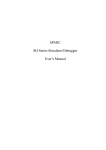



![T] .1](http://vs1.manualzilla.com/store/data/005831826_1-5c5b79be6c7f2f902c022f1ff12b7474-150x150.png)
